

|

|
| See Homepage. | This page: Can anyone shed light on this interesting old car's history? |
Mystery car - information sought.An old friend of mine is researching the history of an oddball, spaceframe chassis, sportscar/special from the early 1960s. We've known each other since 1990, having met up at the (then) Staffordshire Polytechnic thanks to our mutual admiration of archaic, outmoded, motor vehicles. He at the time was running a sit-up-and-beg Ford Prefect, while I had use of my Mk1 A40 and, later, a red Mk3 Spitfire. Over the years we've both had some fairly unusual vehicles. His fleet right now includes gems such as a cracking Austin A40 Sports, an A40 Van, a Citroen GS, and a Falcon Mk2 special, not forgetting the aforementioned E493A Prefect. |
| But what of this next car? No-one seems to know exactly what it is. Matthew rescued the rolling chassis at the tender age of 15, in 1986. By this time, the distinctive fibreglass bodyshell had long since been scrapped, although fortunately a few photographs of the near-complete car, taken by someone who went to view it way back in the 1970s, do survive. A fibreglass creation, as so many one-off specials of the early 1960s were, it doesn't look like any commercially-available bodyshell that we've yet to clap eyes on. It's most distinctive feature, barring its unusual styling, are the "gull wing" doors. |
As it was in the 1970s.Below are a few photographs showing the car, as it was in the '70s. To me the bodywork looks like a one-off, built maybe using an existing bodyshell as a starting point. The wraparound windscreen for instance, isn't the best fit within its surround. Perhaps the car started out with a less curved screen, before being altered - presumably to improve forward vision for the driver - to incorporate the replacement shown below. It looks like a rear screen taken from a contemporary car of the day, similar to that fitted to the Sunbeam Rapier. |
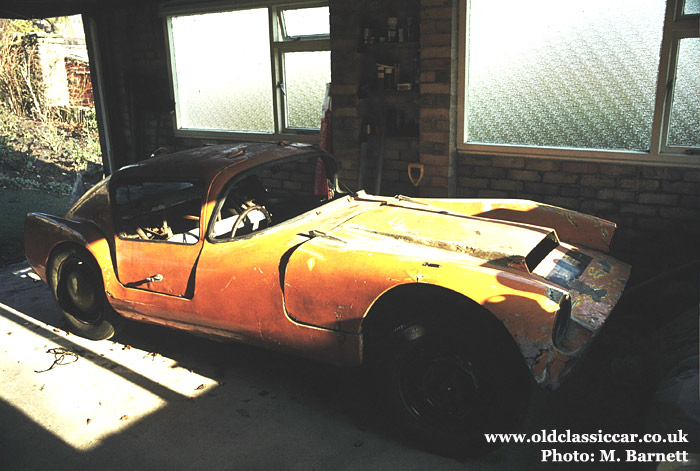
|
| The second shot shows the car, as viewed from behind. The registration, 499 EXE, hails from the Luton area (as confirmed on the XE registrations page here at OCC), late 1962 or thereabouts. The external hinges for both the gullwing doors, and the bottom-hinged opening rear bootlid, can be seen. Does the bodyshell look familiar to anyone reading this? Dolphin, one of many suppliers of bodyshells to the hordes of 1172cc Ford special builders in the 1960s, has been one suggestion. |
| Evidently it was built as a roadgoing car, but the effort that went into the creation of the spaceframe chassis - shown further down this page - does indicate that maybe the creator had half an eye on club motorsports at the time also. This whole subject raises a great many questions, not least of which is this - did the body and chassis start out together? Was the chassis built for another project, then adapted and fitted with a road-car body at a later stage, in 1962? |
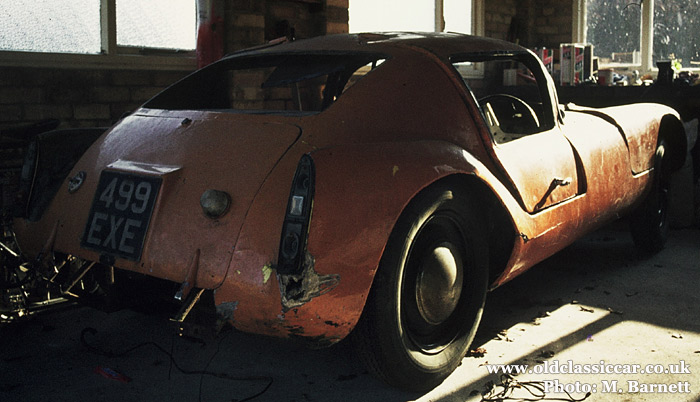
|
| Here, the body has been removed to expose the relatively complicated spaceframe structure. The wheels are from a 1950s Hillman. |
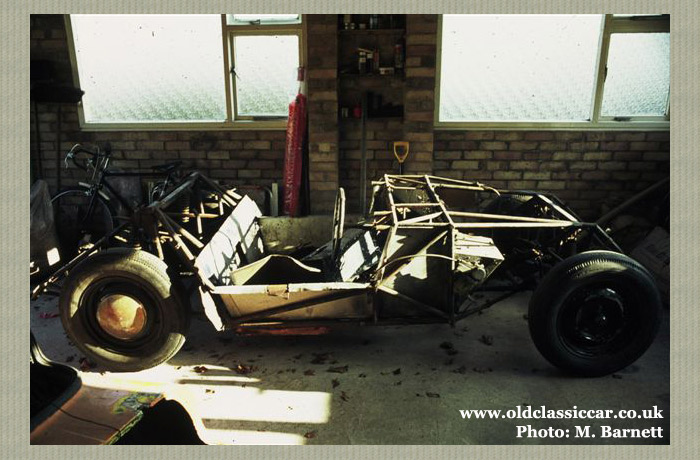
|
| Next, a peek through the car from the rear. |
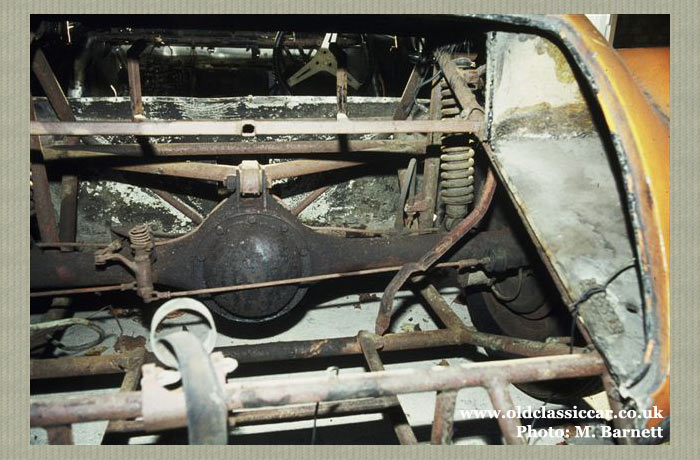
|
| The forward end of the chassis. Unfortunately the original engine had gone by this time, although the suspension, and rack & pinion steering, were still in place. |
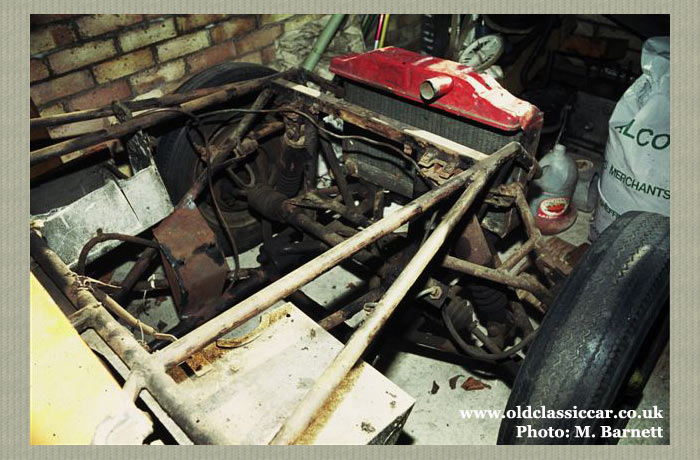
|
As rescued, in the 1980s.By the time Matthew found the car, it had been scrapped, then rescued again by someone else (minus body) from whom Matthew then bought the remains. Since then he's been trying to establish its past. Clearly, whoever built the chassis was quite a handy engineer, which seems slightly at odds with the less-refined bodyshell it once carried. More detail of the chassis front end, and the suspension, can be seen in this photograph, taken in the late 1980s. Note the selection of upper shock absorber mounting positions that were available. Intriguingly, the chassis sports a number on it: GD628/1, which may - or may not - give a clue as to its creator. |
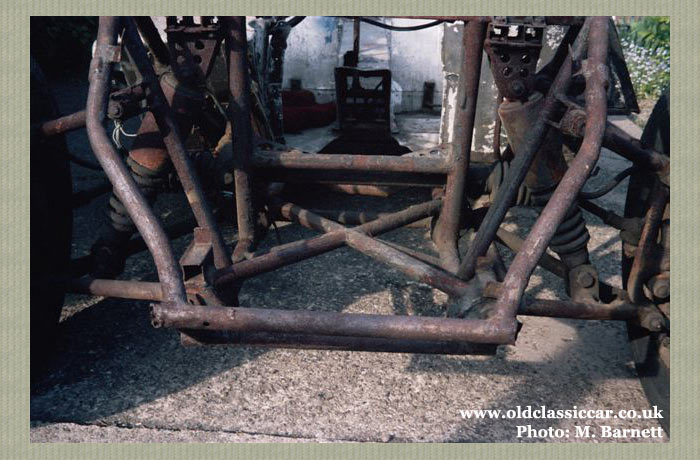
|
| Next a shot of the rear end. |
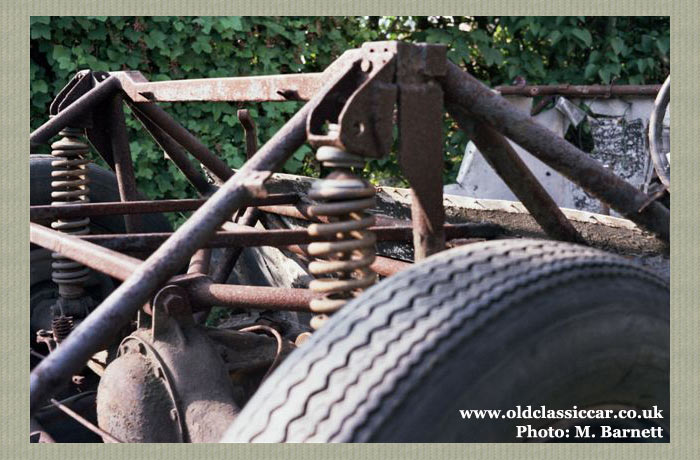
|
| The complete rolling chassis, as purchased. |
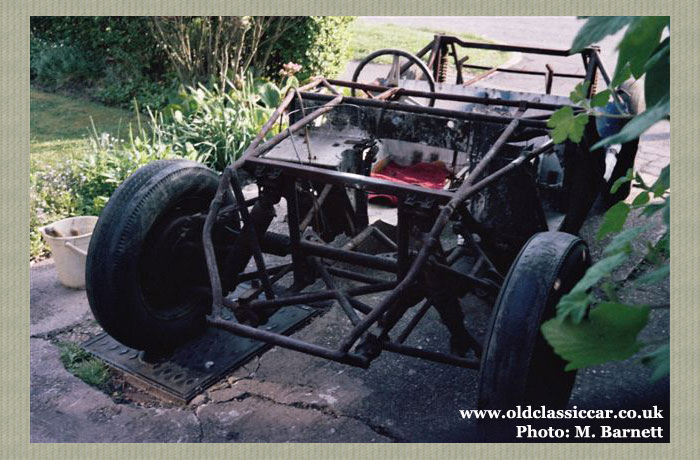
|
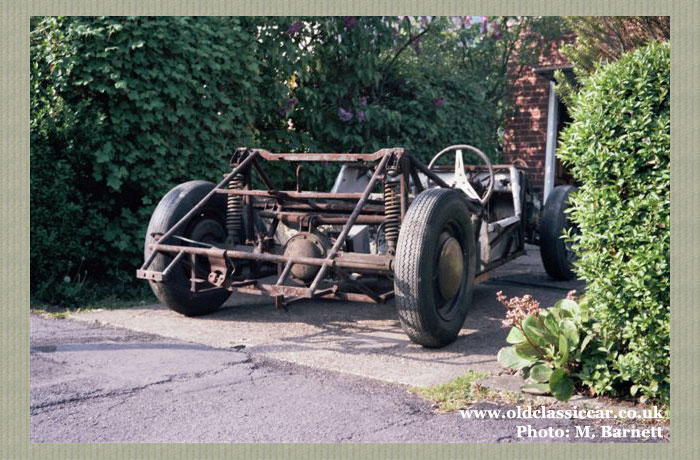
|
| The bare frame, and inset a photograph of the re-furbished chassis that currently does duty beneath the Falcon Mk2 bodyshell mentioned earlier. The chassis is currently fitted with a BMC A Series engine. |
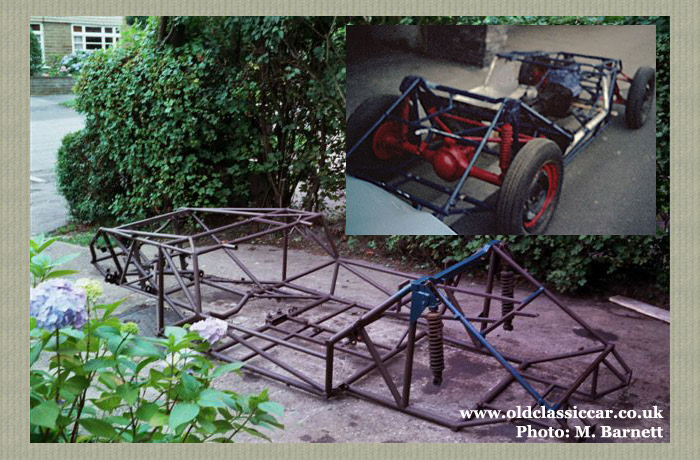
|
What is known currently of the car's background.So far, the following is known about the car, and the parts that went into making it.
|
| One contact that Matthew has been in touch with, offers the following suggestion with regard to the chassis builder: |
|
"To me the chassis looks very much like the work of that New Zealand chassis designer and welder that worked with Microplas up at the Harefield Brickyards site in the early 1950s. Kiwi, as he was known of course, would knock up a chassis to meet your specification, usually with a view to putting a Microplas body on it, be it a Toledo or a Mistral, or whatever.
Kiwi wasn't always entirely practical in that he loved small tube space frames. One day building a chassis around an engine supplied by the customer, he put a diagonal straight over the top of the engine compartment. I said Kiwi, how would you get the engine out should you need to service it? Oh, he said just cut the tube out and then weld it back in once the engine is re-installed. From memory Eric Martin's 1172 Formula special, which had a Microplas shell, had a Kiwi chassis." |
| Does anyone remember seeing 499 EXE during the 1960s or 1970s? The body has echoes of many Ford 1172cc special bodies in it. For instance, from the rear there are shades of (much modified) Convair GT. The chassis is going to be trickier to pin down I think, certainly the level of work that has gone into the detail of its design suggests that it may well have been destined for road and track use. |
| Matthew adds: |
|
"Yes I think it had been on the road or even raced -- there were springs
wrapped round the outside of the brake drums. Plus evidence of wear and tear when I did the re-build.
I do not know what engine was in the car but I think it had been swapped at some time - the pictures of the engine mounting brackets were no match for the quality of the chassis ... somewhere I have a steel plate etched badge that came with the the car. I could not read what it said but it has a very distinctive shape - I will track it down. Also there was evidence that the gearbox mounting had been changed - and the central tube cut and lowered to allow a bigger gearbox. A propshaft came with the car fitted with flanged Hardy Spicer joints at each end - this bolted perfectly to a Morris Marina gear box flange - so it could suggest that the last gearbox was Austin or MG. The original steering shaft and mounting is a work of art - with claw and balljoint. The rear suspension has been modified - the front had approx 1" spacers in it to raise it (this could suggest a heavier engine fitted). Suspension mounting points are adjustable - suggests racing / development. I guess with a car like this you would use it and develop it as you went along. It must have been much more work/cost than just using a Ford Pop chassis - whoever built this knew what they were doing. I drove a VX220 when I was at Lotus - the driving experience and noise was unbelievably similar to driving my mystery chassis." |
| If any more information comes to light, I'll add it in here. Read more old-car owners' stories in the Your Cars section, here at OCC. |
|
|

Custom Search
|
 |
| Old Classic Car (C) R. Jones 2025. Content not to be reproduced elsewhere. |
| Website by ableweb. |
| Privacy Policy, Cookies & Disclaimers |